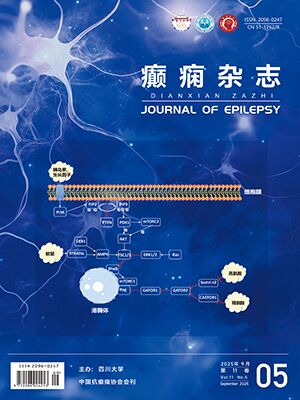| 1. |
Karoly PJ, Ung H, Grayden DB, et al. The circadian profile of epilepsy improves seizure forecasting. Brain, 2017, 140(8): 2169-2182.
|
| 2. |
Karoly PJ, Goldenholz DM, Freestone DR, et al. Circadian and circaseptan rhythms in human epilepsy: a retrospective cohort study. Lancet Neurol, 2018, 17(11): 977-985.
|
| 3. |
Baud MO, Kleen JK, Mirro EA, et al. Multi-day rhythms modulate seizure risk in epilepsy. Nat Commun, 2018, 9(1): 88.
|
| 4. |
Leguia MG, Andrzejak RG, Rummel C, et al. Seizure Cycles in Focal Epilepsy. JAMA Neurol, 2021, 78(4): 454-463.
|
| 5. |
Staley K. Molecular mechanisms of epilepsy. Nat Neurosci, 2015, 18: 367-372.
|
| 6. |
Ko GY, Shi L, Ko ML. Circadian regulation of ion channels and their functions. J Neurochem, 2009, 110: 1150-1169.
|
| 7. |
Itri JN, Vosko AM, Schroeder A, et al. Circadian regulation of A-type potassium currents in the suprachiasmatic nucleus. J Neurophysiol, 2010, 103(2): 632-640.
|
| 8. |
Gerstner JR, Smith GG, Lenz O, et al. BMAL1 controls the diurnal rhythm and set point for electrical seizure threshold in mice. Front Systems Neurosci, 2014, 8(1): 121.
|
| 9. |
Li P, Fu X, Smith NA, et al. Loss of CLOCK results in dysfunction of brain circuits underlying focal epilepsy. Neuron, 2017, 96: 387.
|
| 10. |
Gachon F, Fonjallaz P, Damiola F, et al. The loss of circadian PAR bZip transcription factors results in epilepsy. Genes Dev, 2004, 18: 1397-1412.
|
| 11. |
Lipton J, Yuan E, Boyle L, et al. The circadian protein BMAL1 regulates translation in response to S6K1-mediated phosphorylation. Cell, 2015, 161: 1138-1151.
|
| 12. |
Ramanathan C, Kathale ND, Liu D, et al. mTOR signaling regulates central and peripheral circadian clock function. PLoS Genet, 2018, 14: e1007369.
|
| 13. |
Saxton RA, Sabatini DM. mTOR signaling in growth, metabolism, and disease. Cell, 2017, 168: 960-976.
|
| 14. |
Besag FMC, Vasey MJ. Prodrome in epilepsy. Epilepsy Behav, 2018, 83: 219-233.
|
| 15. |
Herman ST, Walczak TS, Bazil CW. Distribution of partial seizures during the sleep-wake cycle: differences by seizure onset site. Neurology, 2001, 56(4): 1453-1459.
|
| 16. |
Pavlova MK, Shea SA, Scheer FAJL, et al. Is there a circadian variation of epileptiform abnormalities in idiopathic generalized epilepsy? Epilepsy Behav, 2009, 16: 461-467.
|
| 17. |
Herzog AG. Catamenial epilepsy: update on prevalence, pathophysiology and treatment from the findings of the NIH Progesterone Treatment Trial. Seizure, 2015, 28: 18-25.
|
| 18. |
van Campen JS, Valentijn FA, Jansen FE, et al. Seizure occurrence and the circadian rhythm of cortisol: a systematic review. Epilepsy Behav, 2015, 47: 132-137.
|
| 19. |
Gruenbaum SE, Chen EC, Sandhu MRS, et al. Branched-chain amino acids and seizures: a systematic review of the literature. CNS Drugs, 2019, 33: 755-770.
|
| 20. |
Vezzani A, Balosso S, Ravizza T. Neuroinflammatory pathways as treatment targets and biomarkers in epilepsy. Nat Rev Neurol, 2019, 15: 459-472.
|
| 21. |
Olson CA, Vuong HE, Yano JM, et al. The gut microbiota mediates the anti-seizure effects of the ketogenic diet. Cell, 2018, 173: 1728-1741.
|
| 22. |
Jessberger S, Parent JM. Epilepsy and adult neurogenesis. Cold Spring Harb Perspect Biol, 2015, 7: a020677.
|
| 23. |
Bartolini E, Sander JW. Dealing with the storm: an overview of seizure precipitants and spontaneous seizure worsening in drug-resistant epilepsy. Epilepsy Behav, 2019, 97: 212-218.
|
| 24. |
Karafin M, St Louis EK, Zimmerman MB, et al. Bimodal ultradian seizure periodicity in human mesial temporal lobe epilepsy. Seizure, 2010, 19: 347-351.
|
| 25. |
Durazzo TS, Spencer SS, Duckrow RB, et al. Temporal distributions of seizure occurrence from various epileptogenic regions. Neurology, 2008, 70: 1265-1271.
|
| 26. |
Pavlova MK, Shea SA, Bromfield EB. Day/night patterns of focal seizures. Epilepsy Behav, 2004, 5: 44-49.
|
| 27. |
Hofstra WA, Spetgens WP, Leijten FS, et al. Diurnal rhythms in seizures detected by intracranial electrocorticographic monitoring: an observational study. Epilepsy Behav, 2009, 14: 617-621.
|
| 28. |
Passarelli V, Castro LHM. Gender and age influence in daytime and nighttime seizure occurrence in epilepsy associated with mesial temporal sclerosis. Epilepsy Behav, 2015, 50: 14-17.
|
| 29. |
Loddenkemper T, Vendrame M, Zarowski M, et al. Circadian patterns of pediatric seizures. Neurology, 2011, 76(1): 145-153.
|
| 30. |
Nagaraj V, Lee S, Krook-Magnuson E, et al. Future of seizure prediction and intervention: closing the loop. J Clin Neurophysiol, 2015, 32(1): 194-206.
|
| 31. |
Brigo F, Igwe SC, Del Felice A. Melatonin as add-on treatment for epilepsy. Cochrane Database Syst Rev, 2016, 11(8): CD006967.
|
| 32. |
Oggier DM, Weisbrod CJ, Stoller AM, et al. Effects of diazepam on gene expression and link to physiological effects in different life stages in zebrafish Danio rerio. Environ Sci Technol, 2010, Oct1,44(19): 7685-7691.
|
| 33. |
Griggs CA, Malm SW, Jaime-Frias R, et al. Valproic acid disrupts the oscillatory expression of core circadian rhythm transcription factors. Toxicol Appl Pharmacol, 2018, 339(1): 110-120.
|
| 34. |
Ben-Cherif W, Dridi I, Aouam K, et al. Chronotolerance study of the antiepileptic drug valproic acid in mice. J Circadian Rhythms, 2012, 10: 3.
|
| 35. |
Maturana MI, Meisel C, Dell K, et al. Critical slowing down as a biomarker for seizure susceptibility. Nat Commun, 2020, 11(1): 2172.
|




